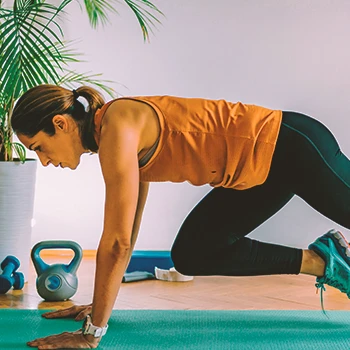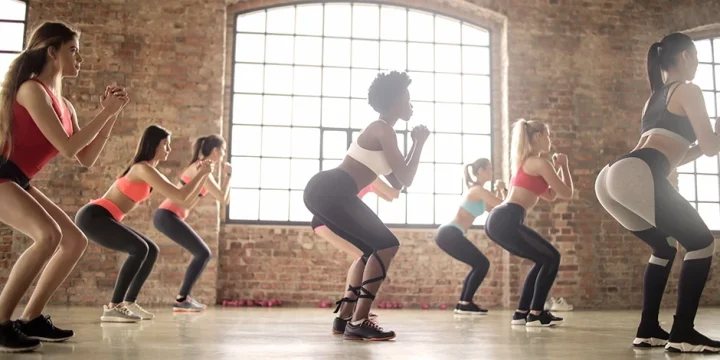For my fitness clients looking to slim down and tone up, I make sure they combine strength training and cardio.
This article will explore various types of workouts that my clients have successfully used to achieve their goals.
From compound movements like push-ups to HIIT to burn more calories, you’ll know by the end of this article what exercises to add to your next workout to get those muscles toned.
Let’s begin.
Quick Summary
- To achieve a toned body, incorporate a mix of weightlifting and cardio into your gym routine.
- Do not target the same muscle group during consecutive sessions for adequate rest and recovery during strength training.
- According to the Mayo Clinic, cooling down after exercise is crucial for gradual heart rate and blood pressure recovery.
- In my opinion, combining different types of cardiovascular training, like HIIT and LISS, is essential for a well-rounded and effective body toning regimen.
Workout and Tone Your Whole Body

The following workout plan includes exercises to work each major muscle group in your upper and lower body.
You will mix up the reps, sets, and rests each week for three weeks.
I recommend following this routine three times a week for nine weeks. After that, it's important to switch up the exercises to prevent your body from adapting too much.
While a Monday, Wednesday, and Friday schedule is effective, if it doesn't suit you, make sure to do your strength training on non-consecutive days to allow for adequate rest and recovery.
Warm Up
Spend 5–10 minutes warming up before exercising. Doing so increases the temperature and flexibility of your muscle fibers, ensuring an efficient and safe training session.
A general rule of thumb is that the more intense the upcoming activity, the longer you should spend warming up.
Keep it simple with walking, push-ups, or sit-ups. You can even do a slower version of the activity you will be doing.
For example, if you are cycling, spend a few minutes warming up by pedaling at a leisurely pace.
Cool Down
As important as warming up before exercise is, so is cooling down, which allows for gradual heart rate and blood pressure recovery.
You can do the activity at reduced intensity for 5–10 minutes to cool down. For example, according to the Mayo Clinic, if you run, slow the pace to a jog or walk to cool down [1].
Workout One: Shoulders, Biceps, and Triceps

- Dumbbell Shoulder Press
- Cable Upright Row
- Dumbbell Rear Delt Raise
- One-Arm Cable Curl
- Barbell Curl
- Dumbbell Concentration Curl
- Dumbbell Triceps Kickbacks.
- Single-Arm Dumbbell Triceps Extension
- One-Arm Reverse Pushdown
Workout Two: Thighs, Hamstrings, and Calves
- Barbell Squats
- Leg Extension
- Dumbbell Walking Lunges
- Dumbbell Stiff-Leg Deadlift
- Lying Leg Curl
- Cable Abductor Raise
- Standing Calf Raise
Workout Three: Chest, Back, and Abdominals

Workout three has you engaging your core muscles and gaining muscle mass in your chest and back.
- Barbell Incline Bench Press
- Dumbbell Flat Press
- Dumbbell Incline Fly
- Reverse Lat Pulldown
- One-Arm Dumbbell Row
- Dumbbell Pullover
- Cable Weighted Crunches
- Leg Raises
Week One
For week one, perform 2-4 sets of 8–10 reps for each exercise. Rest for 60–90 seconds between sets.
Week Two
Week two focuses on developing not only muscle tone but also work on muscular endurance.
By altering the rep and rest intervals, you can kick-start the fat-burning effect that will leave you feeling stronger and leaner.
Perform three sets of 15–20 reps per set of the above exercises.
Rest a maximum of 30 seconds between sets.
Week Three
Week three will introduce a drop set; once you’ve completed reps on the last set, you’ll reduce the weight by 30% and push to failure, giving your muscles an extra challenge to push the limits.
Cardiovascular Training

As a trainer, I always emphasize the importance of variety in cardiovascular training. By switching up your cardio workouts, you can ensure that each session targets different muscle groups.
Simple changes, like alternating between running and cycling, can be enough to reap these benefits.
Low Impact Steady State Cardio (LISS)
Some firmly believe that you should spend cardio days doing HIIT to get the most benefit from your time. While LISS requires more time, there are several benefits.
These include:
- An excellent option for beginners
- Aids weight loss
- Reduces injury risk
- You can use it as a recovery session a day after HIIT
- Improves mood
- It allows you to train for endurance events effectively
- Quick recovery due to less stress on the body
A brisk walk, cycling, swimming, and using a rowing machine are all great LISS options.
“When doing LISS cardio, the goal is to keep your heart rate around 50 to 65 percent of your maximum heart rate.”
- Sara Lindberg, BS, BMed
High-Intensity Interval Training

Incorporating HIIT into your fitness journey is a great way to burn calories, promote weight loss, and get toned quickly.
There are many other benefits to HIIT.
HIIT can:
- Regulate blood sugar levels
- Improves cardiovascular function
- Reverse age-related muscle decline
- Offer more enjoyment than other types of exercise
Here is a sample HIIT workout.
Static Cycle:
- Minutes 0-4: Begin with a light pedal at medium resistance.
- Minutes 4-10: Pedal at high resistance for 15 seconds (total effort), then low resistance (recovery) for one minute and 15 seconds. Do four complete rounds.
- Minutes 10-20: Pedal at full speed with high resistance for 20 seconds, then pedal at low resistance for one minute and 40 seconds; complete six rounds.
- Minutes 20-25: Cool down by pedaling at low resistance. Take your time and don’t skip this part, as, according to WebMD, it helps regulate body temperature and heart rate and prevents the buildup of lactic acid, which causes muscle cramping and stiffness [2].
Related articles:
Role of Nutrition in Body Toning
To complement workout plans for effective body toning, specific dietary choices play a crucial role.
- Prioritize lean proteins like chicken, fish, and plant-based options to aid muscle repair and growth.
- Incorporate complex carbohydrates such as whole grains and sweet potatoes for sustained energy, crucial for endurance in toning exercises.
- Healthy fats from avocados, nuts, and olive oil are essential for joint health and energy balance.
- Hydration is key; water aids in muscle recovery and overall bodily functions.
- Additionally, include a variety of fruits and vegetables for essential vitamins and minerals, supporting overall health and aiding in efficient muscle toning and recovery post-workout.
FAQs
What Is the Fastest Way to Tone and Tighten Your Body?
The fastest way to tone and tighten your body is with proper nutrition, strength training, and cardio exercises, particularly high-intensity interval training. You can often maximize your efforts by taking an all-natural fat-burning supplement.
Can I Transform My Body in 1 Month?
Transforming your body in one month is possible with dedicated effort, focusing on intense workouts, a balanced diet, and sufficient rest, but expectations should be realistic regarding the extent of physical changes achievable in such a short period.
How Long Does It Take To Get a Toned Body?
How long it takes to get a toned body depends on many factors, including your initial body weight, body fat percentage, dietary changes, and the frequency, duration, and intensity of your workouts. With consistency, most see improved body composition in 4–8 weeks.
What Happens to Your Body When You Exercise Everyday?
Exercising daily leads to improved cardiovascular health, increased muscle strength, enhanced flexibility, better mood and mental health, weight management, and reduced risk of chronic diseases, while also boosting energy levels and promoting better sleep patterns.
References:
- https://www.mayoclinic.org/healthy-lifestyle/fitness/in-depth/exercise/art-20045517
- https://www.webmd.com/fitness-exercise/exercise-and-lactic-acidosis
About The Author
You May Also Like






